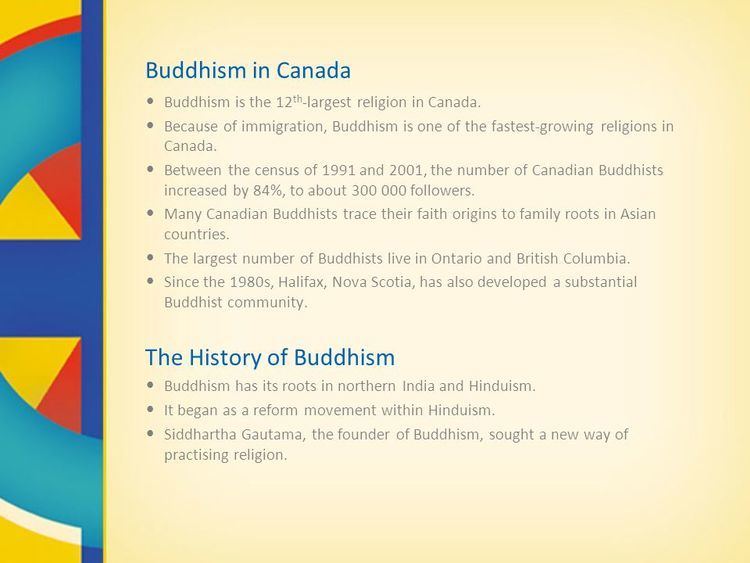 | ||
The rise of buddhism in canada
Buddhism is among the smallest minority-religions in Canada, with a very slowly growing population in the country, partly the result of conversion, with only 4.6% of new immigrants identifying themselves as Buddhist. As of 2001, the census recorded 300,345 Canadian Buddhists (about 1% of the population).
Contents
History
Buddhism has been practised in Canada for more than a century. Buddhism arrived in Canada with the arrival of Chinese labourers in the territories during the 19th century. Modern Buddhism in Canada traces to Japanese immigration during the late 19th century. The first Japanese Buddhist temple in Canada was built at the Ishikawa Hotel in Vancouver in 1905. Over time, the Japanese Jōdo Shinshū branch of Buddhism became the prevalent form of Buddhism in Canada and established the largest Buddhist organization in Canada.
A substantial expansion of Buddhism in Canada began in the last half of the 20th century. Changes in Canadian immigration and refugee policies corresponded to increasing communities from Sri Lanka, Japan, and Southeast Asian nations with Buddhist traditions. In addition, the popularity and goodwill ushered in by Tibet's Dalai Lama (who has been made an honorary Canadian citizen) put Buddhism in a favourable light. Many non-Asian Canadians (Namgyal Rinpoche, Glenn H. Mullin, and Richard Barron for instance) have embraced Buddhism in various traditions and some have become leaders in their respective sanghas.
In 2012, there were 489 Buddhist organizations in Canada, including temples, centres, associations, retreats, charities and businesses. All lineages (Theravada, Mahayana, Vajrayana and Novayana newer schools) are represented. The following universities in Canada have incorporated Buddhist Studies either as a sub-discipline of religious studies, or as a subsidiary to Asian Studies: the University of Toronto has two professors specialized in Buddhism, and the University of Calgary also maintains two professorships related to Buddhism. Smaller universities in Canada will typically have just one professor assigned to Buddhism (sometimes the same professor responsible for all Asian Religions) as, e.g., at the U. of Lethbridge.
Although the temples constructed by immigrant communities in the major cities are more visible (e.g., the Sinhalese "Maha-Vihara" of Toronto), there are also examples of small Buddhist temples constructed by immigrants and refugees in Canada's smaller cities, such as Regina, Saskatchewan's tiny Lao temple.
Various immigrant and refugee populations (Chinese, Tibetan, Lao, Japanese, Korean, Burmese/Myanmar, and Vietnamese) have tried to replicate or maintain their traditions in Canada, while small numbers of Canadians of non-Asian ancestry have also been converting to Buddhism.
Buddhist population
The Buddhist Population in Canada according to the 2011 Census.
Prison population
Prison statistics for the year 2011 indicated that 2% of inmates are Buddhist in Canada's federal prison system.
